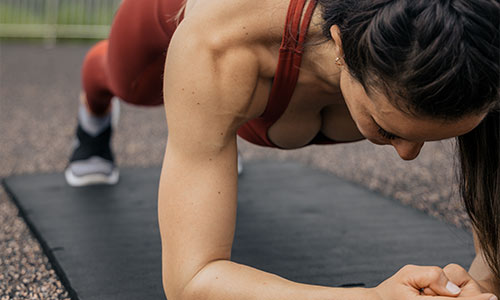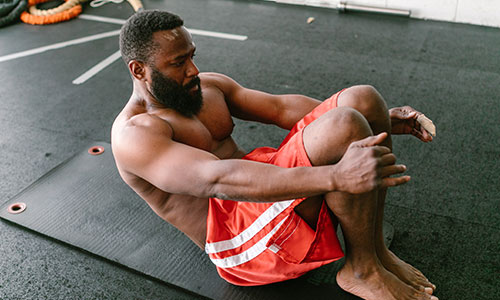Pain-Free Squats: How to Improve Form and Prevent Injuries
Author
Squats, a classic and renowned exercise, is a subject of much debate among fitness enthusiasts and trainers. While some consider it the ultimate movement for fat loss and muscle gain, others are wary of its potential to cause back or knee pain. The key to enjoying the benefits of squats while minimising the risk of injury lies in proper form and technique. In this informative guide, we will explore common issues associated with squats, identify the reasons behind the discomfort, and provide practical tips to perform pain-free squats, enhance strength, and prevent injuries.

Understanding Squat-Related Pain:
- Compound Movement and Muscle Engagement:
The back squat is a compound exercise, engaging multiple muscle groups simultaneously, including the quads, hamstrings, glutes, back, and abs. However, improper muscle activation can lead to pain and discomfort, especially in the lower back.
- Leaning Forward:
Failing to maintain an upright posture during squats can shift the weight distribution, placing excess stress on the glutes, hamstrings, or lower back. Keeping the chest up is crucial for proper muscle engagement and to avoid unnecessary strain.
- Poor Ankle Mobility:
Lack of ankle mobility alters the squatting pattern, preventing natural forward movement of the shins. This can lead to increased stress on the knees and affect overall form.
- Collapsing Knees:
Allowing the knees to cave inward during squats, known as "valgus collapse," can result from technique flaws, mobility issues, or muscle weaknesses. This improper alignment can lead to potential injuries.
- Incorrect Breathing:
Neglecting to breathe properly during squats can reduce intra-abdominal pressure (IUP), affecting core stability and leaving the lifter vulnerable to injury.
- Overreliance on a Belt:
While weightlifting belts have their place, excessive reliance on them can hinder the development of a strong and functional core.

Fixing Your Squat Technique:
- Strengthen Your Grip and Upper Back:
Before squatting, ensure a firm grip on the bar and pull your elbows under it. This creates full-body tension, enhancing control during the squat and protecting the spine and lower back.
- Maintain Proper Posture:
Focus on keeping your chest up and elbows pulled down throughout the squat. Gradually reduce the weight if you experience difficulties maintaining an upright position.
- Address Ankle Mobility:
To compensate for limited ankle mobility, try elevating your heels slightly with a 5- or 10-pound plate. Additionally, include ankle mobility drills to restore normal ankle movement and improve squat form.
- Prevent Collapsing Knees:
During the squat, push your knees out to prevent them from caving inward. Incorporate goblet squats and glute-strengthening exercises like glute bridges and barbell hip thrusts to address this issue.
- Practise Proper Breathing:
Inhale deeply as you descend into the squat and exhale forcefully as you ascend. This technique, combined with bracing your torso, enhances intra-abdominal pressure, promoting stability and injury prevention.
- Use a Belt Appropriately:
Use weightlifting belts as assistance rather than reliance. Save wearing a belt for heavier sets and strive to build core strength during lighter sets.
Conclusion:
The back squat is a powerful and effective exercise for building strength, muscle mass, and overall fitness. By understanding and addressing common issues associated with squats, you can perform them pain-free and maximise their benefits. Strengthen your grip and upper back, maintain proper posture, address ankle mobility, prevent knee collapse, practise correct breathing, and use a weightlifting belt appropriately. With these techniques, you'll be able to squat safely, increase your strength, and prevent injuries, ultimately elevating your overall fitness and athletic performance.
Author
Categories
- Sport (28)
- Product Reviews (3)
- Team Outdoor Look (7)
- Mike Wild (2)
- Mike Payton (2)
- Suse Hammond-Pears (3)
- Snowboarding (12)
- Latest Offers (105)
- Shop Talk (1)
- Competitions (7)
- Walking (413)
- Lifestyle Fashion (8)
- Travel (86)
- Kit Guides (176)
- Workwear Clothing (6)
- Safety Workwear (4)
- Health/Fitness (289)
- Skiing (91)
- Great Outdoors (1316)
- Cycling (92)
- January 2025
- December 2024
- November 2024
- October 2024
- September 2024
- August 2024
- July 2024
- June 2024
- May 2024
- April 2024
- March 2024
- February 2024
- January 2024
- December 2023
- November 2023
- October 2023
- September 2023
- August 2023
- July 2023
- June 2023
- May 2023
- April 2023
- March 2023
- February 2023
- January 2023
- December 2022
- November 2022
- October 2022
- September 2022
- August 2022
- July 2022
- June 2022
- May 2022
- April 2022
- March 2022
- February 2022
- January 2022
- December 2021
- November 2021
- October 2021
- September 2021
- August 2021
- July 2021
- June 2021
- May 2021
- April 2021
- March 2021
- February 2021
- January 2021
- December 2020
- November 2020
- October 2020
- September 2020
- August 2020
- July 2020
- June 2020
- May 2020
- April 2020
- March 2020
- February 2020
- January 2020
- December 2019
- November 2019
- October 2019
- September 2019
- August 2019
- July 2019
- June 2019
- May 2019
- April 2019
- March 2019
- February 2019
- January 2019
- December 2018
- November 2018
- October 2018
- September 2018
- August 2018
- July 2018
- June 2018
- May 2018
- April 2018
- March 2018
- February 2018
- January 2018
- December 2017
- November 2017
- October 2017
- September 2017
- August 2017
- July 2017
- June 2017
- May 2017
- April 2017
- March 2017
- February 2017
- January 2017
- December 2016
- November 2016
- October 2016
- September 2016
- August 2016
- July 2016
- June 2016
- May 2016
- April 2016
- March 2016
- February 2016
- January 2016
- December 2015
- November 2015
- October 2015
- September 2015
- August 2015
- July 2015
- June 2015
- May 2015
- April 2015
- March 2015
- February 2015
- January 2015
- December 2014
- November 2014
- October 2014
- September 2014
- August 2014
- July 2014
- June 2014
- May 2014
- April 2014
- March 2014
- February 2014
- January 2014
- December 2013
- November 2013
- October 2013
- September 2013
- August 2013
- July 2013
- June 2013
- May 2013
- April 2013
- March 2013
- February 2013
- January 2013
- December 2012
- November 2012
- October 2012
- September 2012
- August 2012
- July 2012
- June 2012
- May 2012
- April 2012
- March 2012
- February 2012
- January 2012
- December 2011
- November 2011
- October 2011
- September 2011
- August 2011
- May 2010
- April 2010
- March 2010
- February 2010
- January 2010
- November 2009
- October 2009
- September 2009


Submit a Comment